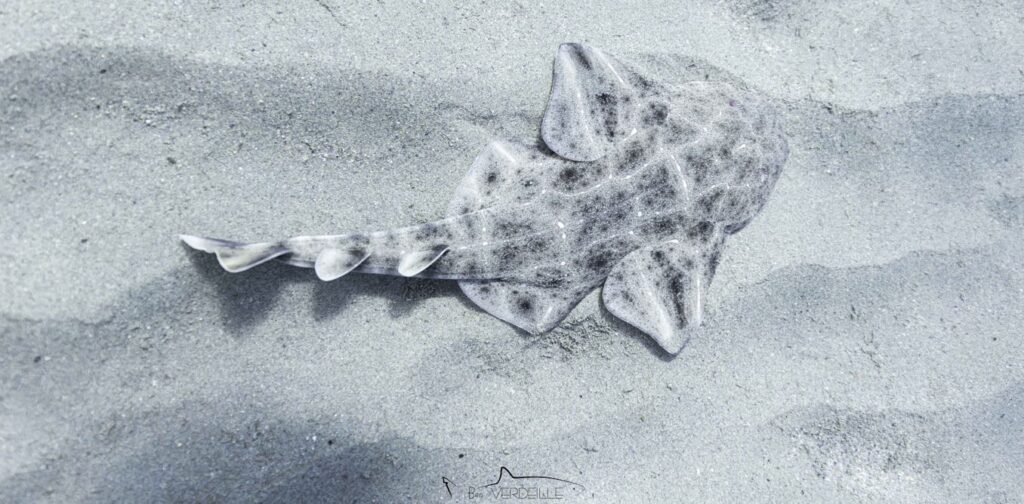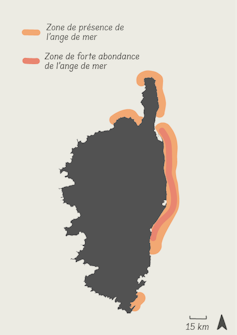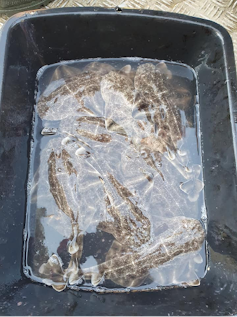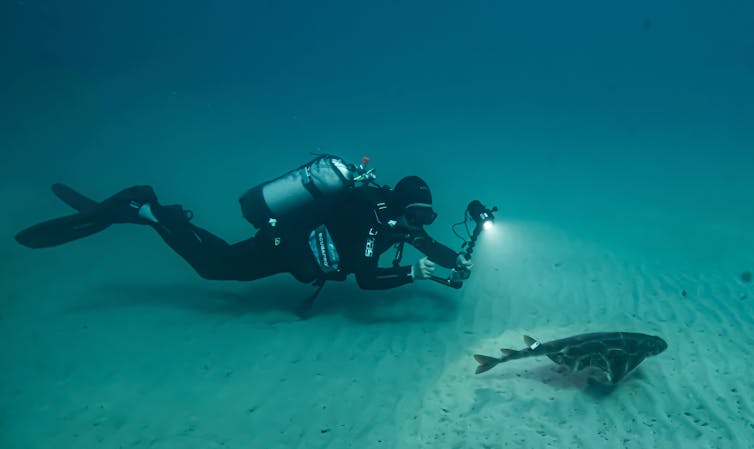Corsican fishermen reveal one of the last refuges of the angel shark
Once common in the Mediterranean, the angelshark is now one of the world's most endangered species. A partnership between scientists and fishermen has led to the discovery of one of its last refuges in Corsica, in order to gain a better understanding of this discreet shark and , ultimately, to protect it more effectively.
Eric Durieux, University of Corsica Pascal-PaoliCaroline Bousquet and Johann Mourier, University of Montpellier

The angel shark is a flat shark that lives on coastal sandy bottoms. Once common throughout the Mediterranean and Northeast Atlantic, it is now one of the world's most endangered species (Critically Endangered according to the IUCN), and as such is an emblem of marine biodiversity at risk.
The angel shark, which even gave its name to the Baie des Anges in Nice, had been missing from the French coast for decades, but that was without counting on the Isle of Beauty, where it has found a veritable refuge. If you indulge in a chat with fishermen from the ports of Bastia to Solenzara, they're unanimous: the angel fish has always been, and still is, present on Corsica's coasts. And that's good news.
This shark has large lateral fins, reminiscent of an angel's wings, and can spend several hours in the sand waiting for its next meal. Like many shark species, it has a slow reproductive rate (8 to 10 months gestation), a low number of young per litter (7 to 25), and a late sexual maturity, making it particularly vulnerable to anthropogenic pressures.
Corsica, the angel's last refuge
The angelfish disappeared from over 90% of its territory during the 20th century, a victim of intensive fishing, particularly with bottom trawls, and the destruction of its habitat. Once a commercial species, it has been protected in all European Union waters since 2010. It was long thought that the Canary Islands were the world's last refuge for this shark, but the knowledge of local Mediterranean - and therefore Corsican - fishermen tells a very different story.
In Corsica, this discreet yet fascinating species seems to have a preference for the large sandy expanses of the eastern plain. And with good reason: the low level of fishing - mainly artisanal - coupled with an ideal habitat comprising hundreds of square kilometers of sand, several estuaries and one of the largest Posidonia meadows in the Mediterranean, classified as a Natura 2000 site and coordinated by the Corsican Environmental Office. Artisanal fishermen, out at sea as soon as the weather permits, are veritable sentinels of the sea, and as such are regular observers of this species. https://www.facebook.com/plugins/video.php?href=https%3A%2F%2Fwww.facebook.com%2FTF1Info%2Fvideos%2Fcorse-le-dernier-refuge-du-requin-ange%2F1916073955444067%2F&width=500&show_text=false&height=281&appId
The invaluable expertise of small-scale fishing
The aim was therefore to set up a partnership between scientists and artisanal fishermen to improve knowledge of this iconic species in Corsica. The Corsic'Ange project (starting in 2022) aimed in particular to gain a better understanding of the distribution and spatio-temporal dynamics of the species in Corsica, on the one hand thanks to the empirical knowledge of the fishermen, and on the other hand by setting up specific monitoring at population level by conventional tagging and at individual level by electronic tagging to understand its movements and behavior.
The first step was to cross-reference fishermen's memories with scientific information, in order to draw up an inventory of the presence of the angel shark in Corsica.
Imagine a coastline 150 kilometers long - just what you need to get from Paris to the Normandy coast - and 5 kilometers offshore. This is where we're looking to study the angel shark. In other words, looking for a species on the brink of extinction in such a large area is like looking for a needle in a haystack.

That's why we turn to small-scale coastal fishermen to study this species. Their years of offshore experience save precious time: they know exactly when and where to find them. It was with a few of them that we learned that the species is present all year round on the coast at depths of up to a hundred meters, but that gatherings of several dozen individuals take place in winter and spring.
How many people are there and how is the population structured?
Identifying the species' functional zones (breeding, nursery, resting and migration corridors) is fundamental to improving conservation measures. The reproduction of the angel shark, in particular, is very poorly documented and only one nursery area has so far been located in the Canary Islands.
The partnership with fishermen continued with a Capture/Mark/Recapture (CMR) survey on the east coast of Corsica, enabling the population size to be estimated. Angelfish caught accidentally were fitted with individual "spaghetti" tags and released. In 18 months of monitoring, 214 angelfish were tagged and 19 were recaptured, giving a recapture rate of 9.7%, which already suggests a significant population size.

This monitoring also enabled us to better understand the structure of this population, in terms of the distribution of young-of-the-year, juveniles, subadults and adults. Observations vary seasonally, being more frequent in spring and summer with mainly adults and sub-adults, while juveniles are more often encountered in winter. Newborns have also been observed, as some females give birth aboard fishing boats. These observations are the first evidence that could confirm the presence of a nursery area on the east coast of Corsica.
These data have also enabled us to identify a new potential area of frequentation north of Cap Corse in summer 2023, with two individuals captured, including one already tagged in the waters north of the eastern plain. This recapture revealed that angel sharks can travel up to 70 km per year. The movements of tagged sharks vary, with some remaining faithful to one area from one year to the next, while others travel greater distances.
How can we study the behavior of this species?
We know that it prefers sandy and muddy stretches to depths of around 150 m, although it usually stays between 10 and 50 m, and that juveniles and pregnant females frequent estuary entrances and brackish waters. However, little is known about the behavior of this species, particularly in the Mediterranean.
To understand their lifestyle, acoustic telemetry was used between July 2022 and November 2023. A transmitter (tag) was placed on 28 individuals, measuring between 63 cm and 1.20 m. Here again, capture and tagging were based on a close partnership with fishermen.

The areas of frequentation, identified by fishermen, were gridded with 58 acoustic receivers (fixed hydrophones) between Bastia and Solenzara. Of the 28 sharks tagged, 24 were detected by the hydrophone network: 7 males and 17 females.
Although no north/south migration has yet been identified on the eastern plain, a migration from the depths to the coasts does take place. Angel sharks frequent the Posidonia meadow and deeper waters in summer, then the coasts and river mouths in autumn/winter.
The angelfish's home range is divided into two zones: the home range and the core activity zone. The home range is the area in which they spend most of their time, 95% of their time, in search of food and reproduction. Its core zone of activity, on the other hand, represents the area it will use 50% of its time, and is its preferred zone.
The analyses carried out show that the size of the home range is affected by the size of the shark. The larger the individuals, the larger the home ranges.
The sex of the animal is also a determining factor. Males tend to have a larger home range: on average 60 km2 versus 35 km2 for females. The core zones of activity are smaller, at around 13 km2 for males and 8 km2 for females. These differences may be explained by the tendency of males to mate with several females and thus be more active in the search for partners, increasing their movements.
Over the entire period studied, angel sharks were most often detected stationary, i.e. silted up, both during the day and at night. This indicates that their swimming activity is not greater at night, as might be assumed, and that these sharks spend almost 75% of their time in silts.
There are, however, a few exceptions... Some sharks, which are in the minority, are most often detected at times when they are on the move. For other rare individuals, such as a female tagged in the summer of 2022, the rates of activity are reversed, with significant silting during the day and very high swimming activity at night.
These still preliminary observations have not yet revealed all the species' behaviours, but since then other data have been collected which will enable us to improve our estimates of the species' home territories and activity rhythms.
The results of this study bode well for the future! Working with professional fishermen is essential to better understand one of the last populations of this species on the brink of extinction on a global, Mediterranean and national scale. Continuity of the monitoring initiated in Corsic'Ange is essential and will enable us to estimate the size of the population, its genetic connectivity with Greek, Lybian and Atlantic populations, as well as behavioral differences on an individual scale and between related individuals. The partnerships set up within theAngel Shark Project are opening up new avenues of study and new methodologies. The improved knowledge provided by this scientific-fishermen partnership is helping to promote the conservation of the angel shark in Corsica by directly involving local stakeholders, as well as more widely in the Mediterranean and throughout its range.

This article is published as part of the Fête de la science (which takes place from October 4 to 14, 2024), and of which The Conversation France is a partner. This year's theme is "Ocean of Knowledge". Find all the events in your region on the Fetedelascience.fr website.
Eric Durieux, Senior Lecturer in Marine Ecology, University of Corsica Pascal-PaoliCaroline Bousquet, Scientific Assistant, Office de l'Environnement de la Corse and Johann Mourier, Junior Professor in Fish Behavioral Ecology, University of Montpellier
This article is republished from The Conversation under a Creative Commons license. Read theoriginal article.